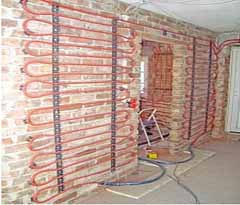
Wall heater combined with clay
Underfloor heating systems react more slowly to climate changes, require higher flow temperatures and cause dust swirling. As a result of the smaller area requirement, the client saves installation material for wall heating systems, thus lowering the production costs. Wall heaters radiate radiant heat and can be combined with clay or lime. You will find several reasons to deal with this technique in more detail.
Arrangement of heating surfaces
Wall heaters are considered low-temperature heating. Their flow temperature is below 45 degrees Celsius. Two aspects determine the planning of the heat registers: the wall surfaces with the lowest surface temperature indicate the order. From this point, the specialist optimizes the further area distribution as a function of the heat demand calculation. Furniture distribution plays an important role in the planning process. Because there is little point in concealing the wall heating behind a large cabinet wall or a kitchen line. Comfort zones can be actively planned, for example by arranging the heat registers at seating groups, dinches, resting areas or workplaces.
Wall heating can be combined with clay
Radiation heat is felt by the human being as soothing, since it comes close to the natural conditions. The building material clay stores the heat of the heating elements and transfers them evenly to the room. The wall heating can be plastered conventionally with clay. The thickness of the plaster will be well thought-over. Too much pipe coverage reduces the heat output and lowers the reaction rate. The thickness of the entire plaster assembly is between 30 and 35 millimeters, with a pipe cover of 10 to 15 millimeters.
In the interplay between heating engineers and plaster manufacturers, the basic conditions have to be clarified. The clay plaster should not tear during heating and subsequent cooling. Observe the manufacturer’s instructions. The craftsman must also be familiar with the system.
A two-ply application with embedding of a glass fiber fabric and subsequent fine-graining is recommended. In the meantime, system manufacturers offer a combination of wall heating and drywall elements. This is especially useful for timber construction, as the builder is keen on a short construction period and wants to avoid a moisture entry into the building. As with wet plaster, the dry elements are reinforced after installation and a fine plaster is applied as the top layer.
Usefull link
www.lehmwandheizung.de/ German Website of Uwe Berghammer
picture source: www.lehmwandheizung.de
